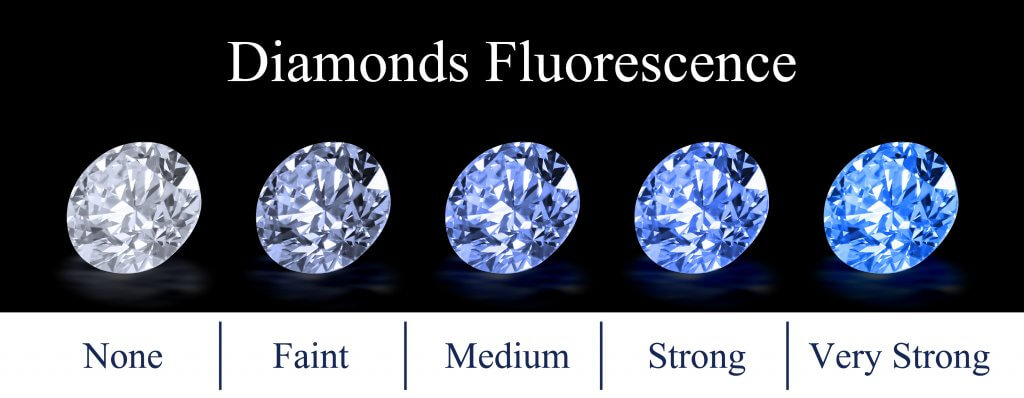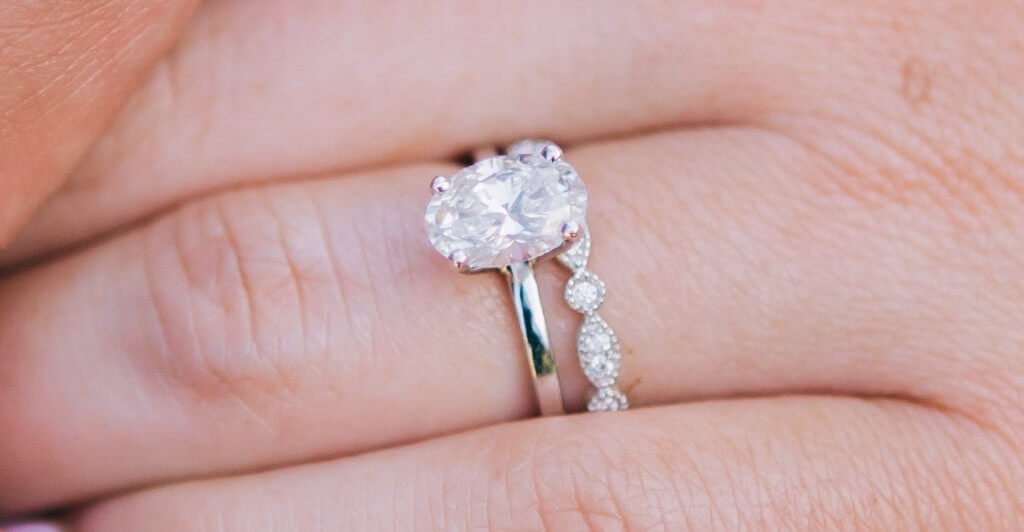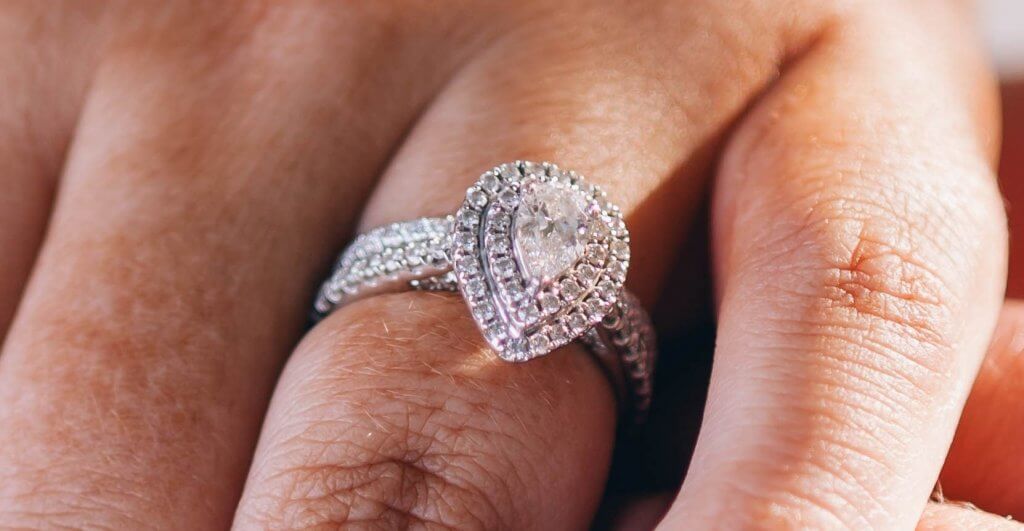The Negative Effects Of Fluorescence On Diamond Appearance
Key Takeaways
- Along with the Four Cs, diamond fluorescence is another important conversation to have with your jeweler.
- It can be both a good thing and a bad thing, as it can lower the visual appeal and the value of the diamond itself, but some do enjoy the unique look of a fluorescent stone.
- The grades for fluorescence are ‘None’, ‘Faint’, ‘Medium’, ‘Strong’ and ‘Very Strong’.
- A strong fluorescence can interfere with a diamond’s transparency, so they should be avoided if possible.
- Avoiding a fluorescent diamond altogether, however, is not essential to attaining the perfect engagement ring. Anything from ‘None’ to ‘Medium’ should be acceptable, but make sure to actually see the diamond before you decide on this.

Odds are that, by now, you’ve done at least some of the required reading on the Four Cs of Diamonds. In the very least, you’re probably aware of the fact that a diamond’s quality is determined according to cut, color, clarity, and carat weight, and that these categories represent the most pressing things for any shopper to consider before committing to a diamond.
Still, there’s a little more to it than that. Diamond fluorescence represents yet another important conversation to have with your jeweler – and, as a result, an important subject to add to your radar as you begin your search for the perfect diamond.
Fluorescence can be a great thing for your diamond. It can also be a bad thing, and significantly lower the visual appeal and value of your diamond. Confused? Don’t panic – knowing the basics, and working with an experience jeweler, will ensure you don’t make any mistakes.
What is Diamond Fluorescence?
Some diamonds fluoresce, meaning that they glow under backlight. This glow is typically blue, although the glow varies from faint to bright – and, in more severe cases, can be to the detriment of the diamond’s appearance.
Fluorescence is not just a phenomenon reserved for white shirts under the disco blacklights – it’s also a pretty common occurrence in nature. Many minerals, from opal to fluorite itself, will glow under UV lights – diamond included.
The majority of diamonds glow blue under UV light – and not to the extent that the appearance of the diamond is impacted under usual lighting conditions, or daylight. Other diamonds will fluoresce different colors, such as red or green, but this is very rare.
Some diamonds, however, are so fluorescent that they can appear cloudy under direct sunlight. Their value can be lowered alarmingly, particularly if they have a high color grade.
Are Fluorescent Diamonds Real?
Absolutely. Diamond fluorescence is entirely natural, and caused by trace amounts of minerals that react to UV light.
Diamonds don’t simply ‘turn’ fluorescent – it is something that occurs during their development underground.
As a result, you definitely don’t need to worry that a reaction to UV light (however minor) is a sign of a fake diamond. Provided the diamond you are looking at is accompanied by a valid GIA Report – which can be verified for authenticity via our Grade & Score Check – then you can be sure that the diamond is real.
Are All Diamonds Fluorescent?
No, it is thought that just under a third of diamonds mined from the earth fluoresce.
This is yet another thing that serves to demonstrate quite how unique and fascinating every diamond really is. Around 70% of diamonds have no fluorescence at all, meaning that, in many cases, this subject doesn’t impact a shopper’s decision at all.
Still, it’s very important to know that fluorescence can exist in a diamond, and that it’s not always ‘no big deal’.
How Does GIA Grade Fluorescence?
The grades for fluorescence are: None, Faint, medium, Strong, and Very Strong.
While it is not talked about as much as the Four Cs, a diamond’s fluorescence is checked and recorded within its GIA report. Since it impacts a relatively small number of diamonds – and impacts the value of even fewer than that – the topic is not considered to be as pressing as other natural or human-made features.
Still, shoppers should be weary of any diamond that stray beyond the range of None, Faint or Medium. Strong and Very Strong Fluorescence is considered pretty undesirable, for a few key reasons…
What Does Strong Fluorescence Mean in a Diamond?
Strong fluorescence means that the diamond will glow bright blue under blacklight, and that it is likely to appear sort of ‘milky’ under normal lighting conditions.
It also means that its value could be up to 70% lower than it would be for a similar diamond with faint or no fluorescence, since the diamond’s appearance is permanently affected by its own fluorescence.
Why are Fluorescent Diamonds Worth Less?
Only diamonds with a strong – very strong fluorescence marked on their GIA certificate – strong enough for the diamond’s appearance to be impacted under blue lighting conditions – are worth less.
As we mentioned above, many diamonds fluoresce so weakly that this quality does not have any discernible impact on appearance under normal lighting conditions. In other words, whether the diamond is being in indoor lighting or in the sun, it will not appear to fluoresce.
When this fluorescence becomes too extreme, however, the diamond can look significantly worse than other diamonds with the same grades for cut, color, clarity, and carat. As we mentioned above, a diamond with strong fluorescence may even appear very hazy, and not sparkle as well as it otherwise could.
Is Faint Fluorescence OK in a Diamond?
Yes – you don’t have to avoid fluorescence altogether to find a beautiful diamond. Most diamonds that fluoresce will do so in a way that does not impact the stone under normal lighting conditions.
The GIA introduced this grading system for fluorescence because of the fact that plenty of diamonds fall into the gray area between having no fluorescence at all, and fluorescing so strongly that the beauty of the diamond is all but ruined.
Think of it a little like color. You don’t have to aim for a D Color diamond – or even one of the colorless grades – to find a diamond with no discernible yellow or brown tint. You can afford to shop comfortably around the range of G-I, without any fear of paying over the odds for a visibly discolored diamond.
The same thing holds true for fluorescence. Don’t shy away from any diamond graded with minor fluorescence – just avoid those with fluorescence strong enough to infringe upon the diamond’s everyday beauty.
Is Medium Fluorescence Bad?
Not necessarily, although it should be avoided in diamonds with a very high color grade, as any cloudiness can be more noticeable in these diamonds. In some diamonds, this level of fluorescence is actually thought to benefit the appearance of the stone.
There’s no ‘ideal spot’ for fluorescence, as it can negatively impact diamonds with a higher color grade much more than it impacts diamonds with a slightly lower color grade.
Still, that’s not to say you have to pass up a beautiful diamond simply because of its grade. This is one area where you’ll really want to get the opinion of your jeweler, since they’re the experts in this field. It’s also a very compelling argument against shopping online, since it really is impossible for you to determine how much a diamond’s fluorescence will impact its appearance in real life.
Medium fluorescence still produces plenty of beautiful and wearable diamonds, but this category should be regarded as the upper limit and treated with caution as a result.
In diamonds with lower color grades – particularly those in the lower end of the Near Colorless category on the GIA’s Color Scale – some jewelers feel that a mild fluorescence can improve color, and counteract any slight tint the diamond might have.
Is Strong Blue Fluorescence in a Diamond Bad?
Generally, yes, as this level of fluorescence will interfere with a diamond’s transparency. However, some rare diamonds can fluoresce blue without looking milky – and, for collectors, they hold a very unique sort of appeal.
When it comes to diamond with cloudy/milky appearances, then strong fluorescence is definitely a bad thing. Why? Because the trouble with a cloudy diamond is, unless you’re an expert who understands the different types of diamond inclusions, it won’t look like a real diamond at all. Even people who have never seen diamond ‘in the flesh’ before still know what they’re supposed to look like: bright, vibrant, brilliant, and fiery and, put simply, more beautiful and dazzling than any other gemstone out there. A diamond that is so cloudy and dull that it appears to have had the life sucked out of it is going to appear to most people like cheap imitation.
For instance, diamond simulants like cubic zirconia (CZ) can be cut and polished to look as much like diamond as possible, but they still can’t live up to expectations. CZ scratches easily and, over time, takes on a cloudy appearance – so you can imagine why a cloudy diamond fails to impress experts and non-experts alike.
Put simply, no one wants a cloudy diamond. While they’re pretty interesting things to look at and study under a microscope, they simply don’t live up to the expectations most of us hold for engagement rings, and will fall short on one of the most important traits a diamond has: sparkle. You’re going to wind up paying far more than you should for a diamond that looks like it’s worth a fraction of its price tag.
As we mentioned above, however, a small number of diamonds have strong fluorescence, but no milkiness. In these instances, the strong fluorescence can actually help to make the diamond appear to have a better color than it really does have, when the diamond is exposed to the light. Some people (mainly collectors) enjoy tracking these diamonds down for their pretty unique properties and strong blue glow, which is visible when the diamond is exposed to UV light.
It’s important that you don’t get these diamonds mixed up with fancy blue color diamonds. These diamonds are made blue by the presence of trace amounts of the chemical boron, which ‘contaminated’ the diamond millions of years ago when it was still forming underground. These diamonds appear in varying shades of blue, from pale and icy to a deep, rich shade reminiscent of sapphire (though still offering the diamond’s unparalleled brilliance and fire). Their color is always visible,
Strong blue fluorescence is not always visible within the diamond – it ‘comes out’ when the diamond is exposed to UV light, such as a backlight. Under normal conditions, these diamonds will look pretty normal and unassuming.
Their popularity among certain collectors has made them marketable. The 5th generation diamond cutter Brian Gavin, whose diamonds we have reviewed here, has turned strong blue fluorescence into a selling point. His collection ‘Blue’ comprises diamonds with strong fluorescence, but an AGS light performance grade of 0 (ideal).
The trouble for us is that looking for a diamond with the ‘right amount’ of fluorescence to improve its color is not an exact science. It is far easier and more cost-effective to look at diamonds with a Near Colorless grade of G, H, I, or J. There are plenty of options that show no discernible color or fluorescence. For that reason, the overwhelming majority of buyers looking for a diamond for their engagement ring would prefer to stay safely within the lower grades (None, Faint, and Medium), ensuring little to no fluorescence and a clear, bright, sparkling diamond.
There are flaws worth investing into – inclusions and color that are not visible to the naked eye – but we can’t see the value in investing into a diamond that is flawed in this way. It’ll take you longer, and put you at more risk of a dud.
Is Fluorescence Good in a Yellow Diamond?
In some cases, slight fluorescence can counteract the presence of a minor amount of visible color in a diamond.
This is not something that jewelers would ever recommend you bank on, however. For one thing, finding a diamond with precisely the right amounts of color and fluorescence to cancel one another out could take you a long time, and is not something that can be objectively measured like cut, clarity or color. It would, to a certain extent, be subjective, which can be daunting even for experienced jewelers.
The better approach would be to look at diamonds with a slightly lower (though still eye clean) clarity grade, such as VS2 or SI1, or a slightly smaller diamond – or, perhaps, a diamond shape that’s good at concealing slight color (more on that below) so that you can afford to find a diamond that appears colorless.
While an interesting subject, fluorescence is generally seen as a negative trait in any diamond – and particularly among those looking to create an engagement ring – so don’t commit yourself to a potentially long and frustrating search for a diamond that has both color and fluorescence, but which appears colorless.
So, What is the Best Fluorescence for a Diamond?
Anywhere from ‘None’ to ‘Medium’ on the GIA Scale, although, in any case, you should never settle on a diamond before you have seen it in person, as fluorescence – like any trait a diamond holds – will look different on every stone.
If you’re sticking firmly to the higher grades for color then, ideally, your diamond would have no fluorescence – but, as we said before, don’t let that deter you from an otherwise beautiful diamond. Provided you stick within this range, then the most important thing is what you and your jeweler think of the diamond – and, as we always say, whether or not you think it’s eye clean.
Chances are you don’t want to give your future bride a blue tinted diamond. While they’re pretty cool to look at, they’ll never replace clear, sparkling diamonds as the ultimate token to present when you propose.
Still, you don’t need to beat yourself up if your heart is pulling you toward a diamond that has a certain amount of fluorescence. Talk it through with your jeweler, weigh up the pros and (potential) cons, and let your instincts guide you the rest of the way.

Sep 2, 2021 By Willyou.net
Diamond Color vs Clarity | What Matters More?

Sep 2, 2021 By Willyou.net
Choosing G Color Diamonds: A Complete Guide








